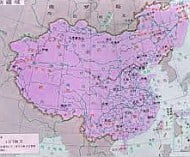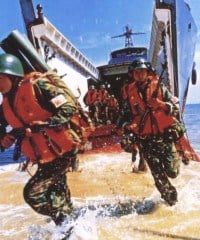This lurid op-ed piece from the Chinese Communist Party’s Wen Wei Po is dated last July and has recently been attracting ridicule on Hong Kong message boards. It lists the six wars China must wage in the coming 50 years in order to achieve national unity. It would be comforting to think it is some sort of satire, but it seems to be a nicely deranged example of zany ultra-nationalism verging on onanistic fantasy (the newspaper puts a ‘personal opinion’ disclaimer at the end).
China today is still building up its military capacity, and as we all know there’s no rush. So things start off in 2020-25 with, it goes without saying, forceful reunification with Taiwan. The author thinks that, even with Japanese and American intervention, China can overcome Taiwanese forces in six months. We live to see the ‘million-man swim’ after all.
After a two-year rest period, it’s time for a 2025-30 push to take over the South China Sea and all its islands. The toughest nut to crack will be Vietnam, and the author suggests conquering it first in order to scare the Philippines and others into submission – a reverse kill-chicken-to-scare-monkeys strategy. He (what makes us assume it’s not a woman writing this?) now declares the ‘first island chain’ broken, giving China’s aircraft carriers access to the ocean. (Been done. The Mainland’s Go-playing armchair generals see the country as surrounded by a hostile ring of islands from Japan to Taiwan to the Philippines and the rest of the Southeast Asian archipelago, as we shall see when the author gets to 2040-45; to keep the fun coming, there’s a ‘second chain’ keeping the motherland hemmed in, comprising places like Hawaii and Guam.)
The rest of us might wonder at this stage what’s happening on the bigger geopolitical stage. Has the UN imposed an embargo on China? Is an India/Australia/Japan/Korea/US alliance about to nuke Beijing? At least, how’s the Hong Kong property market reacting to all this? But no, it’s 2035-40, and time to re-take South Tibet. This is a reference to the Indian state of Arunachal Pradesh, south of the McMahon Line, drawn 100 years ago when the Brits sort of carved off a chunk of Tibet, which of course is an indisputable and eternal and very happy part of you-know-where. The author’s preferred option is to neutralize India by splitting it into lots of different countries; failing that, China will join in a two-pronged attack with Pakistan, which will get Kashmir. China’s space-based weaponry will be especially advanced by this stage, making the job all the easier.
Sharp-eyed observers will be asking about the Diaoyu Islands. Has the author forgotten them? Of course not. As 2040-45 rolls round, China acquires the whole Ryukyu Island chain (Okinawa, etc) from the dastardly Japanese who have for years perpetrated the myth that it is their territory. We’re a bit skimpy on the details of the military action here, but suffice it to say that the rest of the world does nothing and the East China Sea becomes an inland lake of the motherland with little fuss.
 Two wars to go, and some of us may be scratching our heads wondering which parts of the Celestial Empire remain un-unified. A Kuomintang-approved map of China will help jog our memory: Outer Mongolia obviously needs to rejoin its Inner part, where they cheerfully celebrate Genghis Khan as a Chinese hero. So for 2045-50, China brings Ulan Bator and its sprawling, grassy hinterland back into the fold, perhaps with the full approval of the yurt-dwelling, horsemeat-eating inhabitants – otherwise how do we get around the fact that Beijing today recognizes the place as an independent republic?
Two wars to go, and some of us may be scratching our heads wondering which parts of the Celestial Empire remain un-unified. A Kuomintang-approved map of China will help jog our memory: Outer Mongolia obviously needs to rejoin its Inner part, where they cheerfully celebrate Genghis Khan as a Chinese hero. So for 2045-50, China brings Ulan Bator and its sprawling, grassy hinterland back into the fold, perhaps with the full approval of the yurt-dwelling, horsemeat-eating inhabitants – otherwise how do we get around the fact that Beijing today recognizes the place as an independent republic?
And so 2050-55 dawns, and China gets round to its last bit of unfinished unificatory business. After building up forces in Mongolia, China can reclaim the 1.6 million sq km that Imperial Russia stole from the Qing Dynasty back in the 19th Century. This especially means Outer Manchuria, the region north of Korea (think Vladivostok and possibly the island of Sakhalin). The author says this will be the first of these six wars against a nuclear power (wrongly – his attack on India might have brought a nasty surprise), but sees a combined air-land-sea preemptive strike sorting everything out.
Not all ultra-nationalists would agree with this 25-year scenario. Many would argue that the Diaoyus and Okinawa should come first, as that would eject Japanese and US forces from the region right at the start. They might also put South Tibet lower down the ‘to reunify’ list. Some of the really subtle, sensitive, peace-loving ones would say that Taiwan and Mongolia could be absorbed without violence simply through economic blockades.
The rest of the planet and the Moon, it seems, can wait.


Who exactly is going to fight China’s wars ?
Unlike the USA and Russia, for example, there is no ‘surplus’ population in China (cannon fodder, if you like). Every child in China is, and always will be, a Little Emperor. By the time they reach their teens, a very large chunk of the Little Pioneers are overweight, diabetic, smartphone addicted, little tyrants who will NOT put up with hardship, personal obstacles or a lack of computer games and fast food.
China’s ‘anschluss’ in action eh? I can’t wait for China’s next protest about Japanese hegemony in the 1930’s and 40’s without any irony whatsoever. I don’t know why they waste money on the military. A few million cashed up cadres unleashed to buy property in most parts of the world would be far more effective. After all, its working here.
Well said JB. Plus, as any military man will tell you, no plan survives contact with the enemy. The specter of unintended consequences will derail this whole enterprise.
Plans for regional military domination rarely turn out well.
Not to worry even if they do attack. The shells will be found to have been filled with tofu and half the the soldiers will go down with food poisoning
Even Taiwan doesn’t actually have to defeat the PRC – just make the cost of conquest too high to pay. And as for the South China Sea “pick ’em off one by one” scenario, does it not occur to the writer that the other countries around it might set aside their differences and unite against a common foe?
What I really want to know, however, is when Britain is planning to retake Calais?
Pooh! to you, Joe Blow!
You[‘re forgetting one thing that the Wen Wei Po opinionator has surely taken into account.
China’s armies WON’T be composed of the overweight, spoilt, asthma-ridden detrius of the one-child policy, but rather of hordes of gargantuan mega transformer-cyborg robots with deadly ray guns, armies that will be transported instantaneouslythrough hyper-space to any destination on earth.
You hadn’t thought of that, had you, Mr. clever-boots?
every 3-4 years, CCP will rally the troops to pick on the japanese over ancient history..
I was scared initially reading that article given how much of a war-monger CCP is actually is. I seriosly hope that the US, India or Russia let China and the CCP have a few (if not several) mushroom clouds to deter their thoughts on conquering the world…
@ Private Beach
Correction : re-take the top 2/3 of France.
It belongs to Britain in perpetuity via that nasty, sniveling ex-viking-turned- froggie who had the impudence to invade Great Britain by cheating at battle.
(Poor King Harold died in haste, which was one in the eye for Willy the frog)
Sorry to be the pedant, but a big chunk of England’s medieval claim to France was actually in the south-west of the country.
The writer might have a point with India. It’s only one nation because the Brits unified 100s of petty fiefdoms over a nearly 200 year period.
Partition was bloody enough resulting in one becoming three. There’s still countless areas of the place that are more separatist that unionist in belief.
Is it too much to hope that as China completes it’s journey from Medieval shithole to an Asian version of nineteenth century Britain – commercial supremacy without human rights or welfare states – it will educate the masses to see through imperialism.
Nah, silly question
Until recently, Japan and the Philippines were booting the Americans out, but must now be kicking themselves.
I’m not sure if India could take on China — already in 1962 they got their noses bloodied. And there must come a point, maybe reached already?, where China can use the threat of invasion to humiliate Taiwan at every turn.
Asian wars tend to start on some trivial pretext, using the element of surprise, as such agreed conventions as declarations of war or peace treaties are considered a sign of weakness.
@Sojourner “Sorry to be the pedant”
No, you’re not sorry, you love it. Be honest.
Hemlock, Fascinated to read an English translation of the original WWP article?
Many European countries – Germany, Italy, Switzerland – also consisted of numerous petty fiefdoms in relatively recent historical times. Even the “United” Kingdom has sizable separatist movements, as does Spain. Demonisation of one or more external “enemies” is a common political tactic for keeping such states (or empires) unified, but sometimes (Yugoslavia violently, Czechoslovakia peacefully, indeed the Soviet Union) they fall apart.
China’s entire history is a cyclical pattern of expansion followed by fragmentation, and we are currently in an expansionist phase. Despite Bela’s claims of “Yellow Peril mongering”, it would be dangerous to assume the article does not reflect the thinking of at least some parts of the Chinese leadership; nothing in Wen Wei Po appears without approval from some level of the party. Many in Europe similarly dismissed Adolf Hitler’s well-publicised plans as wishful thinking in the 1930s.
I recommend a visit to both the Japanese Invasion Museum in Shenyang and the museum at the Yasukuni Shrine in Tokyo. The contrasting presentations of the same events are most illuminating.
On another take, seven of the worlds bloodiest conflicts have taken place on “Chinese’ soil, usually involving themselves, so it seems that an internal war may, statistically speaking, be far more likely
source:
http://oddtale.com/top-10-bloody-wars-history/
The death tolls Chopped Onions brings to our attention are even greater when considered as a percentage of the total population at those times. And of course, the more ethnic groups China forcibly incorporates within its expanding borders, the more potential it creates for conflict between them.